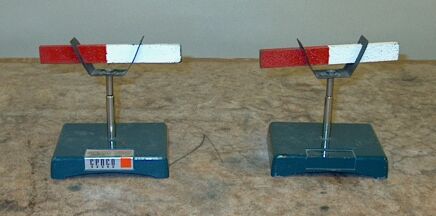
Two bar magnets mounted on swivel stands allow you to show the attraction of unlike poles and the repulsion of like poles.

Two bar magnets mounted on swivel stands allow you to show the attraction of unlike poles and the repulsion of like poles.
The phenomenon of magnetism was known to the ancient Greeks, among them Thales of Miletus (~600 BCE), who observed that lodestone attracted pieces of iron. Lodestone is made of a type of iron ore called magnetite. (Its chemical formula is Fe3O4.) The word magnetism and its derivatives likely come from the district of Magnesia in the adminstrative region of Thessaly in Greece, a place where one can find this material. All samples of magnetite are attracted to a permanent magnet. Only some, however, attract pieces of iron themselves (and are also attracted to a permanent magnet). Lodestone is magnetite that attracts pieces of iron; it has a permanent magnetic moment, and is thus itself a permanent magnet.
The discovery and use of magnetism has a rather long and interesting history. The Chinese knew as early as the early second century CE, that an iron rod brought near a lodestone became magnetized, and that if it were then freely suspended so that it could rotate about a vertical axis, it would orient itself in an approximately north-south direction. This is the basis for the magnetic compass, the first clear description of which is in a Chinese work written in around 1080 CE. The first mention of it in a European work dates to around 1190 CE. Serious study of magnetism began shortly afterward, but the field remained in a state of disarray until 1600, when William Gilbert published a book called De Magnete, in which he laid out in an organized fashion what was then known about magnetism. In addition to what is noted above, among the things that people had discovered by then are the following:
• A lodestone can attract a piece of iron before the two touch, and the attraction still occurs when the two are separated by thin sheets of nonmagnetic material (paper, wood, nonmagnetic metals).
• A lodestone always has two “poles,” as do magnetized pieces of iron.
• If one breaks a lodestone into two pieces, each piece now has two poles, just as the whole lodestone had had; breaking a magnet in two yields two new magnets.
• Like poles repel each other, and unlike poles attract each other.
Gilbert named the pole of the lodestone that swung toward the (geographic) north pole when the lodestone was suspended, the north pole of the stone, and the opposite pole of the stone the south pole. As it happens, the geographic north pole of the earth is near the geomagnetic south pole, and the north pole of a magnet points roughly north. (“Near” and “roughly,” because the axis on which the geomagnetic poles lie is not exactly aligned with the geographic north-south axis of the earth.)
In keeping with convention, the north end of each of the magnets in this demonstration is painted red. By bringing one pole of one magnet near either pole of the other magnet, you can show the repulsion between like magnetic poles and the attraction between opposite magnetic poles. If you set one magnet near the other one, and then turn it on its pivot, you can cause the other magnet to rotate. If you time the motion of the first magnet properly with the motion of the second one, through the periodic attraction and/or repulsion between the poles of the two magnets, you can keep the second magnet turning.
References:
1) Mills, Alan A. Annals of Science, 61 (2004), 273-319 (The Lodestone: History, Physics, and Formation).
2) Sears, Francis Weston and Zemansky, Mark W. College Physics, Third Edition (Reading, Massachusetts: Addison-Wesley Publishing Company, Inc., 1960), pp. 607-8.
3) Halliday, David and Resnick, Robert. Physics, Part Two, Third Edition (New York: John Wiley and Sons, 1978), pp. 717-18.